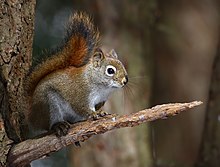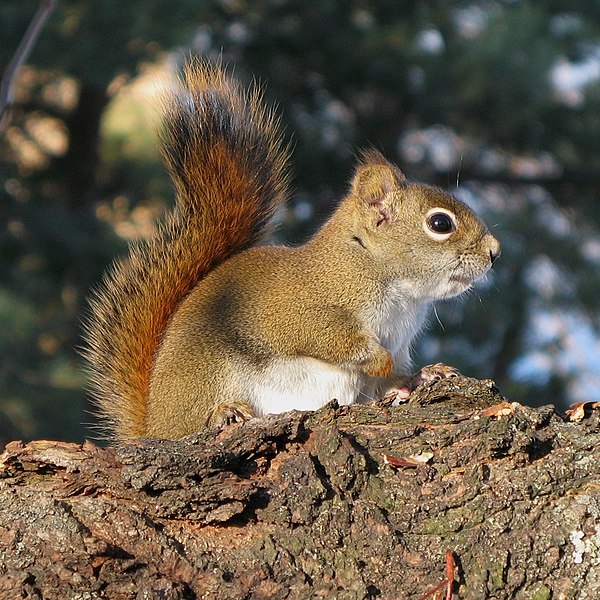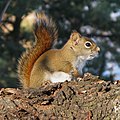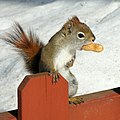
Taxonomy
American red squirrels should not be confused with Eurasian red squirrels (Sciurus vulgaris); since the ranges of these species do not overlap, they are both commonly referred to as "red squirrels" in the areas where they are native. The specific epithet hudsonicus refers to Hudson Bay, Canada, where the species was first catalogued by Erxleben in 1771.[5] A recent phylogeny suggests the squirrels as a family can be divided into five major lineages. Red squirrels (Tamiasciurus) fall within the clade that includes flying squirrels and other tree squirrels (e.g., Sciurus).[6] There are 25 recognized subspecies of red squirrels.[7]Description
Red squirrels can be easily identified from other North American tree squirrels by their smaller size, territorial behavior and reddish fur with a white venter (underbelly).[7] Red squirrels are somewhat larger than chipmunks. The Douglas squirrel is morphologically similar to the American red squirrels, but has a rust-colored venter and is restricted to the southwestern coast of British Columbia and in the Pacific Northwest of the United States. These species' ranges do not overlap.American red squirrel range
Front view, Gatineau Park, Quebec
Behavior
Feeding
Eating nut, in Edmonton, Alberta, 2013
American red squirrels eat a variety of mushroom species, including some that are deadly to humans.[14] They clip and gather truffles and other fungi and place them amongst the branches of trees to dry them in the sun.[15][16][17]
Reproduction
American red squirrels are spontaneous ovulators.[18][19] Females enter estrus for only one day, but venture from their territory prior to ovulation, and these exploratory forays may serve to advertise their upcoming estrus. On the day of estrus, females are chased by several males in an extended mating chase. Males compete with one another for the opportunity to mate with the estrous female. Estrous females will mate with 4 to 16 males. Gestation has been reported to range from 31 to 35 days.[20] Females can breed for the first time at one year of age, but some females delay breeding until two years of age or older. Most females produce one litter per year, but in some years reproduction is skipped, while in other years some females breed twice. Litter sizes typically range from one to five, but most litters contain three or four offspring. Offspring are pink and hairless at birth and weigh about 10 g. Offspring grow at approximately 1.8 g/day while nursing, and reach adult body size at 125 days. They first emerge from their natal nests at around 42 days, but continue to nurse until approximately 70 days.Nests are most commonly constructed of grass in the branches of trees. Nests are also excavated from witches’ broom—abnormally dense vegetative growth resulting from a rust disease – or cavities in the trunks of spruce, poplar, and walnut trees. American red squirrels rarely nest below ground. Each individual squirrel has several nests within its territory, and females with young move them between nests. Some behavior has been reported within human dwellings using insulation as nesting fodder.
A three-year study of a population of red squirrels in southwest Yukon reported female red squirrels showed high levels of multiple-male mating and would even mate with males with similar genetic relatedness. While males mating with multiple females is quite common in the animal kingdom, females that mate with multiple males is rarer. When female red squirrels chose a mate, genetic relatedness did not play a factor. The relatedness of parents had no effect on the neonatal mass and growth rate of their offspring, nor did it affect the survival rate of offspring to one year of age.[21]
Dispersal and survival
Red squirrel swimming
American red squirrels experience severe early mortality (on average only 22% survive to one year of age). The survival probability, however, increases to age three, when it begins to decrease again. Females that survive to one year of age have a life expectancy of 2.3 years and a maximum lifespan of eight years.
American red squirrels are preyed upon by Canadian lynx (Lynx canadensis), bobcat (Lynx rufus), coyote (Canis latrans), great horned owl (Bubo virginianus), northern goshawk (Accipiter gentilis), red-tailed hawk (Buteo jamaicensis), American crow (Corvus brachyrynchos), American marten (Martes americana), red fox (Vulpes vulpes), gray fox (Urocyon cinereoargenteus), wolf (Canis lupus) and weasel (Mustela sp.).[citation needed]












No comments:
Post a Comment
Note: Only a member of this blog may post a comment.